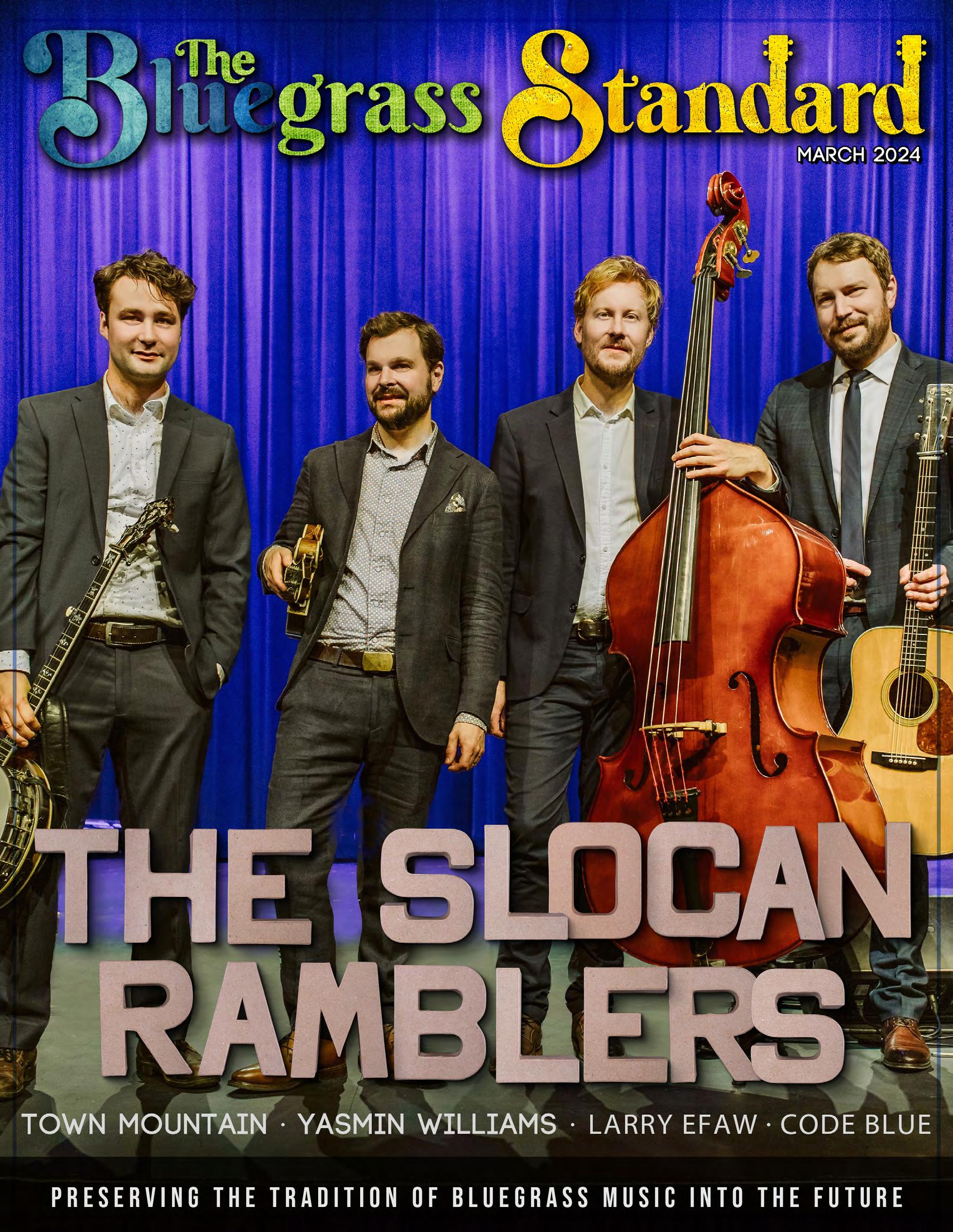

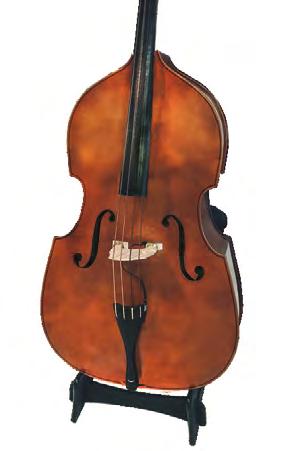




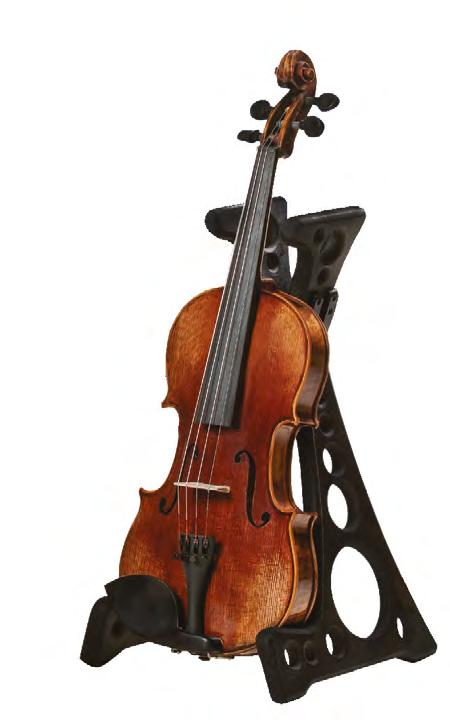

Follow us on: RCWilliamsCompany.com | 913.912.1083 Available in red for an extra splash of color. ©2022 RC Williams Company, LLC. Designed and manufactured by RC Williams. All rights reserved. DESIGNED FOR YOUR BEST PERFORMANCE Find out more about our innovative products today! THE AMAZING DBL BASS BUGGIE® We’re home of the original double bass transport. THE AMAZING BASS STAND Keep your upright bass secure and a comfortable seat while you’re performing. STUDIO G STAND A versatile option for guitarists in the studio or on the stage. Protection for your instrument and comfort for the performer. THE AMAZING MINI X STAND Unique hinged “x” format for smaller stringed instruments such as violins, violas, mandolins, and most ukuleles. Available in multiple heights and natural finish. 2

3





12 38 22 4 OUR CHOICE


Keith Barnacastle • Publisher
The Bluegrass Standard is a life-long dream of Keith Barnacastle, who grew up in Meridian, Mississippi. For three years, Keith brought the Suits, Boots and Bluegrass Festival to Meridian. Now, with the Bluegrass Standard, Keith’s enthusiasm for the music, and his vision of its future, reaches a nationwide audience every month!
Keith@TheBluegrassStandard.com


20 5 CONTENT YASMIN WILLIAMS 08 TONY KAMEL 12 ROCKY MOUNTAIN SLIDES 16 TOWN MOUNTAIN 20 THE SLOCAN RAMBLERS 22 CODE BLUE 27 PICKIN’ IN THE ROCKIES 30 BELLA WHITE 34 LARRY EFAW 38 BON APP-ALACHIA 46 FAN FOTOS 50



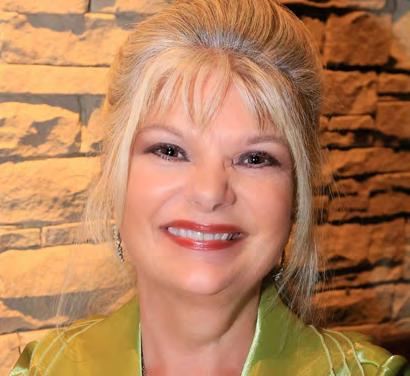

Our Staff
Richelle Putnam • Executive Editor/Writer
Richelle Putnam is a Mississippi Arts Commission (MAC) Teaching Artist/Roster Artist (Literary), a Mississippi Humanities Speaker, and a 2014 MAC Literary Arts Fellowship recipient. Her non-fiction books include Lauderdale County, Mississippi; a Brief History, Legendary Locals of Meridian, Mississippi and Mississippi and the Great Depression. Richelle@TheBluegrassStandard.com
Rebekah Speer • Creative Director
Rebekah Speer has nearly twenty years in the music industry in Nashville, TN. She creates a unique “look” for every issue of The Bluegrass Standard, and enjoys learning about each artist. In addition to her creative work with The Bluegrass Standard, Rebekah also provides graphic design and technical support to a variety of clients.
Susan Woelkers • Marketing
Susan traveled with a mixed ensemble at Trevecca Nazarene college as PR for the college. From there she moved on to working at Sony Music Nashville for 17 years in several compacities then transitioning on to the Nashville Songwritrers Association International (NSAI) where she was Sponsorship Director. The next step of her musical journey was to open her own business where she secured sponsorships for various events or companies in which the IBMA /World of Bluegrass was one of her clients.
Brent Davis • Contributor
Brent Davis produced documentaries, interview shows, and many other projects during a 40 year career in public media. He’s also the author of the bluegrass novel Raising Kane. Davis lives in Columbus, Ohio.
6





Mississippi Chris Sharp • Reviewer
Singer/Songwriter/Blogger and SilverWolf recording artist, Mississippi
Chris Sharp hails from remote Kemper County, near his hometown of Meridian. An original/founding cast member of the award-winning, long running radio show, The Sucarnochee Revue, as featured on Alabama and Mississippi Public Broadcasting, Chris performs with his daughter, Piper. Chris’s songs have been covered by The Del McCoury Band, The Henhouse Prowlers, and others. https://mississippichrissharp.blog
Susan Marquez • Journalist
Susan Marquez is a freelance writer based in Madison, Mississippi and a Mississippi Arts Commission Roster Artist. After a 20+ year career in advertising and marketing, she began a professional writing career in 2001. Since that time she has written over 2000 articles which have been published in magazines, newspapers, business journals, trade publications.
Kara Martinez Bachman • Journalist
Kara Martinez Bachman is a nonfiction author, book and magazine editor, and freelance writer. A former staff entertainment reporter, columnist and community news editor for the New Orleans Times-Picayune, her music and culture reporting has also appeared on a freelance basis in dozens of regional, national and international publications.
Candace Nelson • Journalist
Candace Nelson is a marketing professional living in Charleston, West Virginia. She is the author of the book “The West Virginia Pepperoni Roll.” In her free time, Nelson travels and blogs about Appalachian food culture at CandaceLately.com. Find her on Twitter at @Candace07 or email CandaceRNelson@gmail.com.
7

YASMIN WILLIAMS
by Susan Marquez
Yasmin Williams released her first EP when she was in the tenth grade. “It was a project for my music class,” she says. Her high school in Woodbridge, Virginia, had a music technology program. “They had their own little record label. I stayed after school to record and mix the record, and I also did the album art.” The EP, released in 2012, was titled Serendipity. Not bad for a kid who fell in love with the guitar while playing the Guitar Hero video game with her brothers.
Growing up with four brothers (two younger, two older), Yasmin says music was a constant in her family. “We sang together in the car and in the house. We had a lot of song battles. We were exposed to a lot, music-wise, from jazz and hiphop to R&B and gospel.” She began singing in the church choir at age four. “I
started playing in the concert band in the fourth grade and played the clarinet from that year through college.”
She begged my parents for an electric guitar and amp, then taught herself to play by ear. Yasmin’s first guitar was followed by an acoustic guitar, then a bass, twelve-string, and classical guitars. Yasmin attended New York University, earning a Music Theory and Composition degree in 2017. “I played a few solo shows in New York, and that was a big learning curve for me. I played on campus a lot at receptions and other functions as well. The deans liked me.”
She self-released her first album, Unwind, in May 2018 to critical acclaim. Her next album, Urban Driftwood, was released on SPINSTER in January 2021. The

8

album is a look back at 2020. Finishing the songs during the Covid lockdown, she felt the weight of the social and political climate at the time. “I finished the album’s final track, ‘After the Storm,’ feeling drained, but not wanting to become numb to what was happening in the world.” While you might assume the album would sound heavy, the all-instrumental songs are surprisingly light and joyful. “I wanted the album to serve as a welcomed respite from 2020’s unpredictable and sometimes demoralizing events.”
When asked to describe her style of music, Yasmin calls it “folk adjacent, maybe a bit Americana. I don’t feel that I’m tied down to any particular genre or tradition. I am open to all sorts of multicultural influences.” Her playing style blends inventive fingerstyle techniques and lap-tapping, where she turns her guitar facing up and plays with it on her lap. She somehow creates a layered effect, with her fingers tapping a percussion beat as she plays. Jonathan Bernstein wrote about Yasmin in Rolling Stone: “When Yasmin plays guitar, she captures new possibilities and stories from the instrument.”

Her playlist is eclectic, from jazz to old-time, with artists such as Doc Watson, Virgil Anderson, Christian Scott, and Emily King.
Watching her videos makes it apparent that Yasmin is fearless. Growing up, she had no reference for guitar music. “I tried taking lessons because my parents wanted me to have structure. But that didn’t last long - I wanted to do my own thing.” She has an inquisitive nature, and because of that, she is willing to go out on a limb to try new things. There isn’t just one way to play an instrument in her world, and her resulting sounds are hauntingly beautiful, mystifying, and full of joy.
9

Yasmin was eventually influenced by artists including Jimi Hendrix, Nirvana, and Elizabeth Cotton, “my favorite guitar player ever. All are very experimental.” That probably helped form her own unorthodox style of guitar playing.
Yasmin also plays the kalimba, a type of African thumb piano, and the harp guitar. “Mine is a Timberline parlor-size harp guitar with six floating bass strings. I really like the sound of it.”
In addition to her EP and albums, Yasmin has released five singles, including her newest, Dawning, released in September 2023. The single features Aoife O’Donovan on vocals, Kafari on rhythm bones, and Nic Gareiss on flat foot percussion. “The song came quickly to me,” she says. “I knew I wanted bones on it. And I was excited to have Nic add the flat foot.”
Currently in the studio working on her next album, Yasmin says it is set to be released in August or September of this year on Nonesuch Records. “This album has been a lot of work, as there are a lot of guest artists on it,” says Yasmin. “It will have varying genres, from jazz to bluegrass to world music. I’m super excited about it.”
When she isn’t making music, Yasmin says she loves being outdoors. “I love hiking and tennis, and I’ve dabbled in rock climbing.” She also loves to cook and bake. “I also enjoy making craft cocktails, and I’ve gotten pretty good at it.”

10

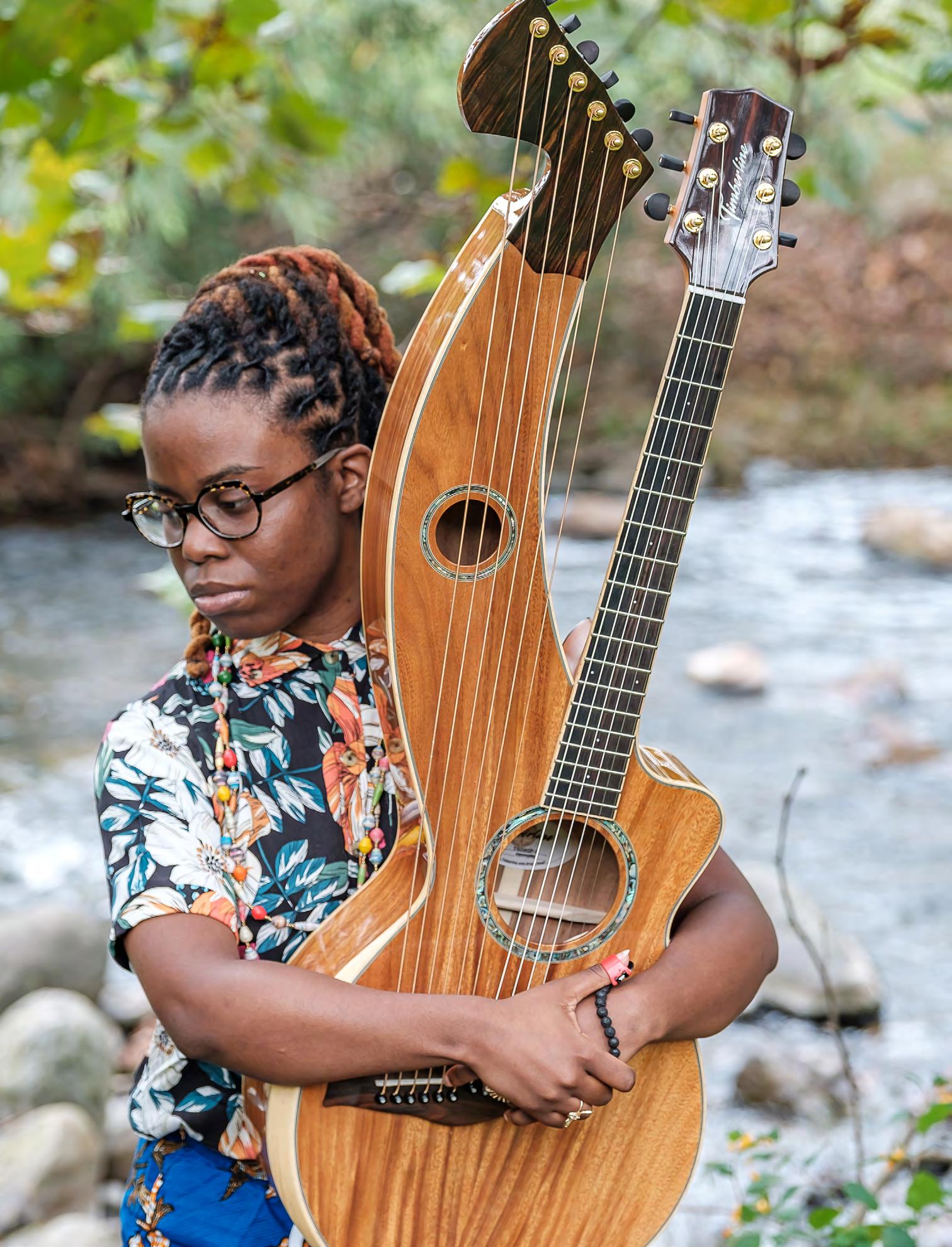
11

Tony Kamel
by Susan Marquez
12

For a guy who never stepped onto a stage until he was thirty years old, Tony Kamel has made up for any lost time over the past decade or so. The bluegrass band he founded in 2011, Wood and Wire, made four studio records and a live album, plus they snagged a Grammy nomination. That’s an impressive record for Tony, who says he wasn’t exposed to bluegrass until around 2005.
Tony was born and raised in Houston and was into athletics throughout high school. He took up guitar at age 12, but just for fun. “Athletics always came first, with music behind that. I never joined a band; I just played around with my cousins. I am pretty much self-taught.” Tony also began writing songs as a teenager. “Stupid stuff, really, but it was a start.”
At the University of Texas in Austin, Tony studied psychology and Italian. “I wasn’t a good student in high school, and I knew if I was going to make it in college, I’d need to study something I was interested in. I studied Italian because my mom’s parents are from Italy. I had the opportunity to study abroad in Italy and got by pretty well with my Italian.”
After college, Tony moved back to Houston, where he took a traditional job as a sales rep for a medical company. “I did that for seven years before moving back to Austin.” When he arrived in Austin, Tony realized many of his friends were gone. Looking for something to do, he became interested in bluegrass. “I found it through jam bands,” he recalls.
“I also learned that UT had a large music library. I looked up bluegrass records and discovered recordings from the Newport Folk Festival, which started in 1959. “I listened to recordings by Ralph Stanley, Bill Monroe, and Doc Watson, who is one of my favorites because he played guitar.” Tony dug in, listening to all he could, and he tried to learn to play bluegrass style by watching YouTube videos. “I then went on Craig’s list to find someone to play with.”
Tony found his community and went to his first music festival in 2007. “I went to the Old Settlers Music Festival in the tiny town of Tillman, Texas. I camped out and jammed all night and loved every minute of it.” The more he hung around the bluegrass scene, the more people he met. He eventually met the guys with whom he would form Wood and Wire in late 2011. “Eight years later, we had a lot of records under our belt, and we were nominated for a Grammy. It was like a dream.”
Being in that band was a wonderful education for Tony. “Our bass player, Dominic Fisher, was a great help to me.” A highlight was playing a concert at Luck, Willie Nelson’s ranch in Texas. “We were one of three acts that played that night, and one of them was Willie and his band. Willie Nelson is one of my favorite guitar players, and it was a real honor just to be in his orbit.”
13
Photo: K Krunk Photography
Wood and Wire has been on hiatus since 2020, and Tony Down Home, for Bruce Robison’s label, The Next Waltz. He analog studio. “It was a great experience.”
He will go into the studio again this month to record a new a flat picker or a clawhammer banjo player, I’m a songwriter although I am more than open to playing other people’s songs.”
Tony says he gets inspiration from a number of artists. “When John Hartford. He is so unique and always did whatever he Carlisle, out of Arkansas. “I think he’s fantastic.”
While music is his passion, Tony says he supplements his pretty handy. I know how to build things like decks and such. deal with keeping up with social media and such. But I don’t control.”
With a wife and a two-and-a-half-year-old, Tony says he can’t regional tour when my new album is released.” Tony is also player who was in The Greencards. We are working on material

14
says he misses it. In 2021, he recorded a solo album, Back He recorded at The Bunker in Lockhart, Texas, Robison’s all-
new album. “I’m writing all the songs,” says Tony. “Before I’m songwriter and singer. I really like making and creating new music, songs.”
“When I have a hard time coming up with something, I think of he wanted. I also like a lot of modern music, including Willi
his income by acting, mostly in television commercials. “I’m also such. It’s difficult to be an artist on your own. I now have to don’t mind. I like keeping things small and maintaining total can’t gig every night, and he limits touring. “I will do a also working with Kim Warren, “a phenomenal mandolin material we can do as a duo.”

15

ROCKY MOUNTAIN SLIDES
by Susan Marquez
It is said that necessity is the mother of invention. If that’s the case, then Doc Sigmier, with the help of his father, created the guitar slide of his dreams. And what a dream. “I never dreamed the slides would be so popular, and this would become a full-time business.”
Rocky Mountain Slides Company, headquartered in Concha Springs, Colorado, was “born” when Doc complained to his dad that he didn’t have a slide he liked. “I grew up in Southern California and saw all the bands that played in Los Angeles in the 1960s and 70s,” he says. “From Buffalo Springfield to The Byrds, and so many more. I grew up loving music.”
While Doc describes his family as “artistic,” he says they weren’t very musical. “They were visual artists. I was the black sheep because all I really wanted to do was music. I always volunteered to play the parts in the band that required a slide – a lot of Marshall Tucker and Allman Brothers tunes. I would play records over and over to learn sound-tuning. But I always had a love-hate relationship with slides.”
Doc worked in radio off and on but really wanted to make his own music. “When I complained to my dad that I didn’t have a slide I liked, he said we should make one.” Doc’s dad was a potter, mainly selling functional pottery in art galleries. “He played with the slides as a side project for a number of years until one day, BAM! I told him that was the one.”

16

They started with one color and one size. “I realized there needed to be different sizes to fit different-sized hands,” Doc says. “Otherwise, it could be like pulling off a Chinese finger puzzle in between songs that didn’t require a slide.”
Doc began talking to other artists. “I loved listening to blues and jam bands, and also Americana. I would ask if they wanted to buy a slide, and most people I asked wanted one to try. And people liked them.”
Explaining the majority of slides that are considered ceramic are porcelain slips. “The clay is poured into molds. They look good, but no R&D went into those slides. A friend gave me one, and it was OK, but not very resonant.” Doc says he went in another direction. What makes Rocky Mountain Slides different is they are made of stoneware, a dense clay. Doc pairs them with custom glazes he and his dad created. “Between the two of us, we were able to get it right. Once we did, we never looked back. We worked together for 13 years.”

Each slide looks like a work of art. “They not only look good, but the sound they provide is exceptional,” Doc says. “Some of the biggest changes in your tone can come from the smallest additions.”
In addition to ceramic slides, Doc has stone and brass slides available. “The stone slides are from our Element series. We made finger slides and tone bars from moonstone, a kind of smoky quartz that makes colors fragment when under light. It’s amazing.”
17

Rocky Mountain Slides also offers handcrafted guitar picks made from various materials, including buffalo bone, buffalo horn, brass, graphite, mother of pearl, tiger eye, coconut husk, and polysynth (a nylon/resin material).
And once again, Doc saw a need and created a new kind of pick. “I had the idea after I kept dropping my guitar picks. I created a new kind of pick I call the Bear Claw. It’s a tri-pick, and the center of the pick is thicker and tapers down towards the edges. It’s ideal for people with arthritis, tendonitis, carpal tunnel, or people who have had strokes. A lot of folks like them to prevent fatigue. With the Bear Claw pick, you don’t have to grip it as tightly. I thought it would work, and when I got the first samples in, I realized it did the job very well.”
Doc says he likes to keep his prices reasonable. “Bluegrass, Americana, and folk artists all spend a lot of money on guitar picks and other additions. I try to be cost-effective for musicians.”
As a musician, Doc says he loves to experiment. “I love hearing the variations that different materials can provide. For example, one material can give a bright tone while another gives a warm tone. It just depends on the sound you prefer. Steel-on-steel was the go-to from the early days of the Hawaiian steel guitar. I offer a non-traditional, artisan-made alternative. I design tools for musicians, and I offer them in a variety of materials. I have been fortunate through the years to have a number of loyal artists who have supported my business. My mantra has always been, ‘Try it. You may like it.’ I am always experimenting.”

18
2024 Berkeley Bluegrass Festival
April 26-28
concerts, workshops, and more
Appalachian Road Show, Laurie Lewis and the Right Hands, Kody Norris, Danny Paisley & The Southern Grass, Never Come Down, Kathy Kallick Band, Broken Compass Bluegrass, Caleb Klauder & Reeb Willms Bluegrass Band, Hard Drive, Marin County Breakdown, Salty Sally, Fog Holler
thefreight.org
19
Town Mountain
by Jason Young
If you have yet to hear Town Mountain, their newest release, Dance Me Down Easy: the Woodstock Sessions EP, will be a perfect place to start. Delving into their musical influences, the roots-driven quintet trekked from their hometown, Asheville, NC, to upstate New York to record at The Barn, the famous studio built by the late Band drummer Levon Helm.
Each song is recorded live with one take; their second effort under New West Records follows their label debut, the highly acclaimed Lines In the Levee (2022 Best American Album of the Year,
Greer takes the lead vocal on Dire Straits 80s mega-hit “So Far Away.” “That song has been on my brain for years,” said Greer. “Being a road- musician,” the guitarist added, “that song just hits to the core. It’s being frustrated about what distance does to two people.”
Expressing high regard for songwriting legend J.J. Cale, whose song “Devil in Disguise” is the first track on the EP, the Town Mountain frontman said that he wasn’t only impressed by the man behind the rock classics “Cocaine,” “After Midnight,” and “The Breeze,” but also his stage attire. “Where other guys had their

PopMatters.)
“The creative juices got started with a buddy of ours, John Allen, who is also president of New West Records,” Town Mountain guitarist/singer Robert Greer stated about their new EP.
He felt that with seven or eight studio albums of original material, recording a covers album would be a good idea. “We jumped on it! If el presidente wants this to happen,” he joked, “it’s going to happen! We thought it was a really cool idea.”

stage clothes, Cale would come out in a white T-shirt, sunglasses and a pair of blue jeans -- he just exudes cool!” Mandolinist Phil Barker added a personal favorite by introducing his bandmates to The Kinks song “Strangers.”
“Phil has been singing that song for at least three or four years,” explained Greer. “We always would ask him, ‘Hey man, what’s that song?’ And he would say, ‘It’s a cool Kinks song.’ So, with this album, we had the opportunity to record it.”
20

Taking center stage on the EP is the title track, “Dance Me Down Easy,” written by Levon Helm. Greer, perhaps the most influential musician of them all, expressed how much Levon means to Town Mountain.
“We have always listened to The Band and other ensembles that Levon has been involved with. He is one of the guys, along with Jerry Garcia, that everyone in the band can agree [was] a major influence.”
When asked about the famous recording location, “It’s been a dream of ours,” explained Greer about Levon Helm’s Studios. “Not only did we get to play there, but we also got to record.”
The guitar picker described the studio vibe. “Soon as you walk in there, man, you can tell it’s not corporate. The high ceilings, the rough-cut lumber. … We get why [Levon Helm] built it here!
Other highlights on the EP include the traditional “Flannery’s Reprise,” featuring Town Mountain fiddle player Bobby Britt.
“We (Town Mountain) recorded it more like the traditional version on our Steady Operator album, but Bobby started toying around with it again -- really slowing it down. I was like, ‘This is not going to work.’ I remember being in rehearsal and asking him, ‘What is your goal here?’”
After recording the song, Greer was surprised by the result, “It ended up being cooler than I thought!” Giving credit to their fiddle player, “Bobby came up with the brilliant idea.”
Through various personnel changes, Town Mountain continues gaining fans. Forming in 2004 in Asheville, NC, a small music landscape compared to the bustling Nashville or LA music scenes, Greer described the original lineup as a “partying drunken mob.” “We were young and spinning our wheels,” adding, “We didn’t have a booking agent for years.”
Reminiscing about the lean times, “We would look out at the crowd and ask if there are any generous souls who have a place where five knuckleheads with sleeping bags can stay.”
Seven albums later, Town Mountain, which now features band members Zack Smith (bass) and Devon Neil (drums), along with Greer, Barker, and Britt, is proud of what it created.
“For a small band that started in a grassroots kind of way, to still be going and employing other people who have families, helping them provide…,” the guitarist paused, “We’re proud of that man.”
21


22
by Kara Martinez Bachman


23

The Slocan Ramblers may be Canadian, but they’ve carved out a solid place in the world of American bluegrass. They were selected as the IBMA 2020 Momentum Band of the Year Award winners and were nominated for a 2019 Juno Award. This past November, these ramblin’ men took a special moment to be still, finding themselves
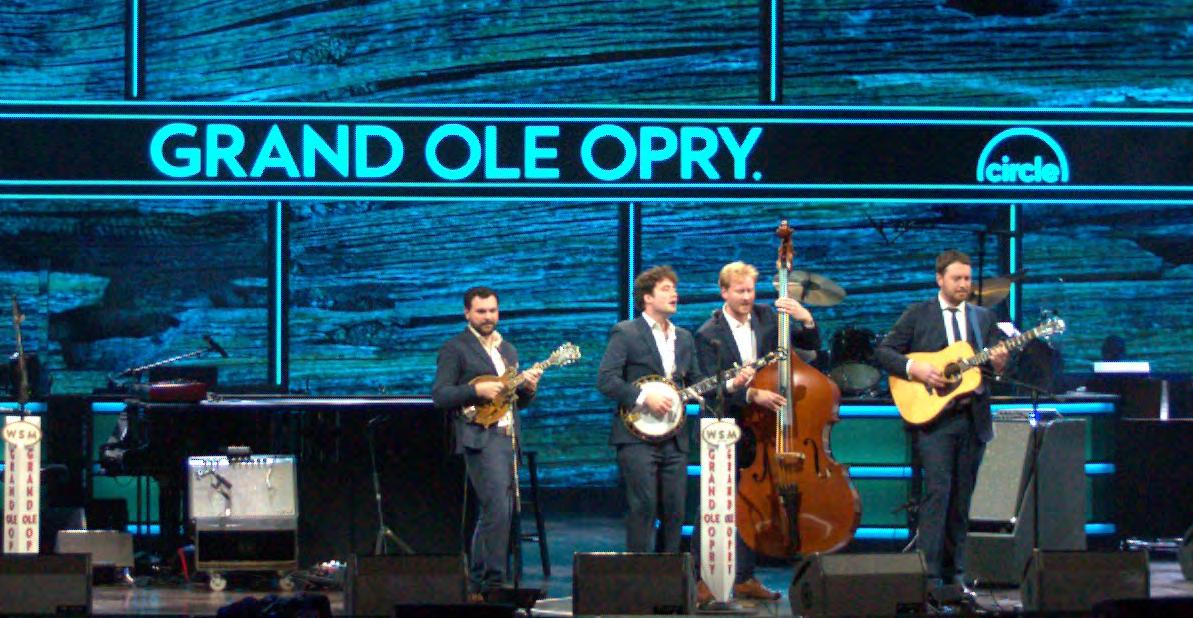
with a sure and perfect grounding in a place they probably never expected they’d ever land: On the stage of the Grand Ole Opry.
“It was kind of an amazing experience to play music in a setting where everybody we learned from got their footing in that same place,” explained The Slocan Ramblers banjo player and vocalist Frank Evans.
The appearance followed a period of support of the band’s 2022 record, “Up the Hill and Through the Fog.” Evans said the 12-track recording – filled with “honest and heartfelt” compositions – was a bit of a departure from their previous records. The process – and its resulting sound – were driven by something over which they had no control: Covid-19. The end result, though, has served them well.
“It was a little bit of a departure from how we normally do it, and that was basically because of Covid,” Evans explained. In the past, they’d shape records around what were essentially live performances. In this case, they had to do their parts in-studio. Live recording simply wasn’t in the cards.
“We didn’t have that luxury this time,” Evans said. “It really is kind of a studio album…but we had a lot of fun creating music that way.”
Evans is joined by fellow “ramblers” Adrian Gross (mandolin) and Darryl Poulsen (guitar and vocals). Although not an “official” band member, Charles James (bass and
24

vocals) is a somewhat permanent fixture attached to the Ramblers, adding his talent to recordings and live shows.
Evans said something new is on the horizon; fans can already start looking forward to new music.
“We’re planning on recording a record this year and will probably do it in Nashville,” Evans said. He explained that they’ll be aiming even higher for this forthcoming record. He said they’ve “always tried to make as big a sound as possible with four instruments,” but the next record will include guest musicians who will “fill in to make the sound even bigger.”
Evans has been at it for a long time; he started on banjo around age nine or 10. His parents took him to a concert in Toronto where he was introduced to the variety of sounds made by different variations of his instrument, including Irish tenor banjo, gourd banjo and bluegrass banjo. He ended up taking lessons for a year from a clawhammer banjo player who had participated in that show.
Evans said his influences – and, in part, the band’s inspirations as a whole – run the gamut. He said his listening preferences over the years have “kind of gone from one end of the spectrum to the other” and have included everything from “old time, archived music on old scratchy recordings” to more modern bluegrass, such as Ricky Skaggs. He said a lot of the old music still affects what The Slocan Ramblers perform today.
“Sometimes the classics are what get people excited,” Evans said. “Everybody goes crazy for the Monroe stuff.”
On the West Coast, fans might be able to catch a show in April when The Slocan Ramblers head out for a California tour. They’re also excited to return for a second time to teach at the RockyGrass Academy at Colorado’s RockyGrass Festival in July.
While the group appears to be making the western U.S. its ramblin’ territory this spring – and will be recording here in the U.S. in Nashville – they’re still Canadian. This fact hasn’t stood in their way.
“Being a Canadian band playing American music, It’s not always clear where we fit in,” Evans admitted, “but it’s always been completely welcoming. It’s always blown us away how welcoming the community is.”
25

26
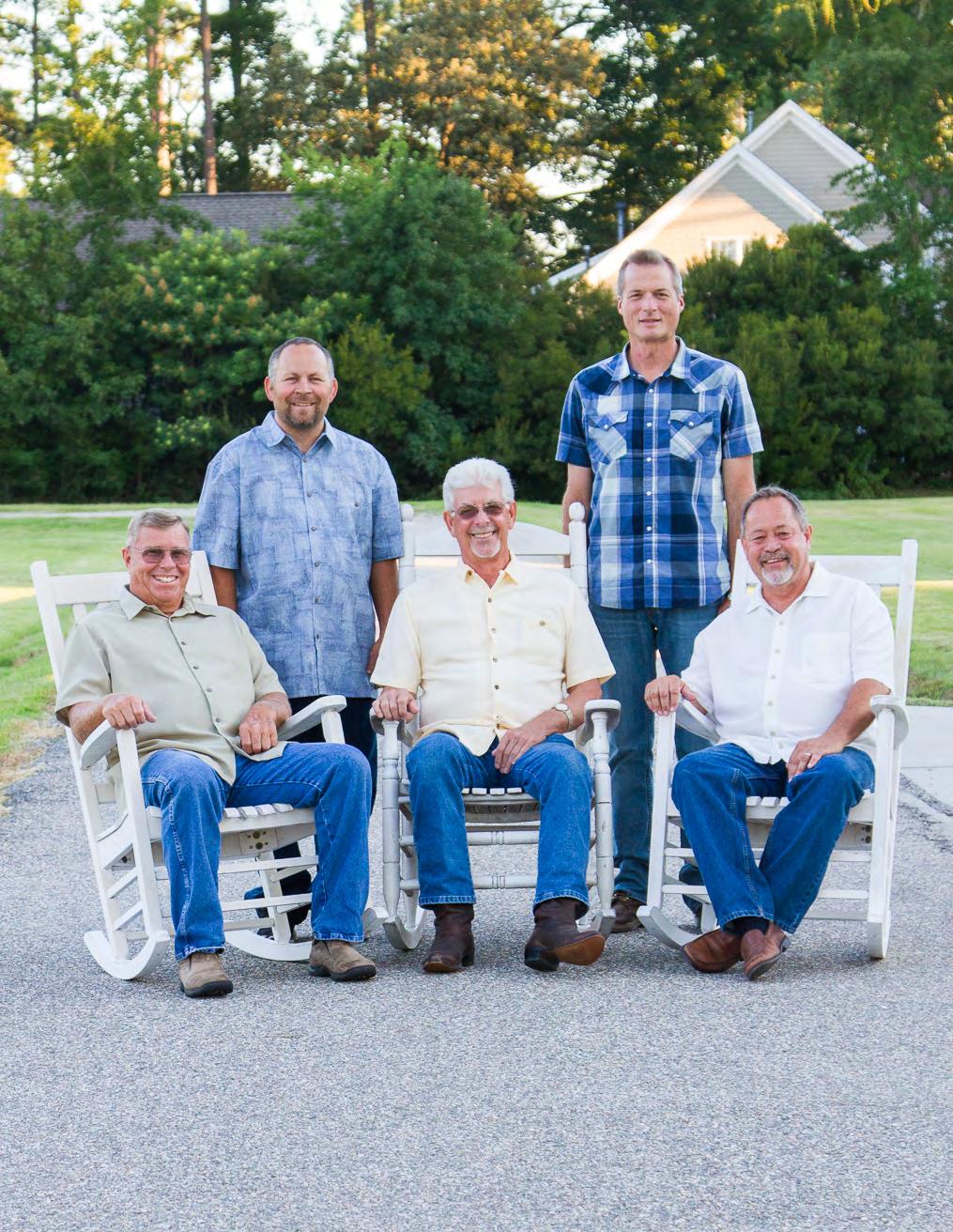
CODE BLUE
by Brent Davis
27

What’s it take to keep a bluegrass band thriving in Virginia’s Tidewater, a region known more for beach music than banjos fiddles and guitars? The experts on the subject might be The Code Blue Bluegrass Band, which formed in 1995 and is still going strong. Part of the secret may be their broad catalog of songs.
“Down in this area, we found you have to kind of do that because it’s not such a staunch, hard-edge bluegrass area,” says Bud Finch, who sings, plays guitar, and does most of the emcee work in the band. “If we were from Kentucky, I don’t know that we would get by with some of the stuff we do. They probably wouldn’t want to hear ‘My Girl’ or something like that. But you have to set your music as to what the area calls for.”
Code Blue is a seasoned bluegrass band with breakdowns and spirited fiddle tunes in its set. But it’s also known for its tight harmonies, strong singing, and engaging stage presence.
“We feel our strength is in our arrangements and in our presentation,” Finch explains. “We’re able to relate to a crowd and connect with people. You have to put on a show. But I think it’s got to be an honest show. It can’t be conjured. An audience can read through that.”
Other members of the band include E.T. Firth (mandolin, guitar, vocals), Mike Beaver (banjo, vocals), Paul Anderson (fiddle), and Bucky Beauchamp (bass, vocals). “Other than Bucky, who’s been with us seven years now, we’ve all been together for the last 24 years,” says Finch.
Learning how to relate to the audience goes beyond the music. Finch says their presentation on stage reflects who they are.
“I just think it’s the makeup of the people
that are in the band. I come from a sales, and marketing, and business background. It’s what I did in my career. Michael, the banjo player, has been a real estate broker by trade for 40 years. He’s a very outgoing guy. He comes from a family of commercial watermen here in the little town where the two of us live. The main prerequisite for joining the band is that we want you to be a good person, and I think all that shows when we’re on stage.”
Audience members may be surprised that a Virginia Tidewater band that includes “Under the Boardwalk” and “Then You Can Tell Me Goodbye” in its shows also plays bluegrass standards such as “Roll On, Muddy River” and “Big Spike Hammer” with authority.
“I get asked a lot, ‘How do you sing bluegrass as well as you do when you don’t really come from bluegrass?’ Well, I don’t think you necessarily have to come from those rural roots in order to feel the music and get the message,” says Finch, a longtime Tidewater Virginian. “I think bluegrass is soulful music. I used to listen to Temptations-type music all the time. I just think if it’s heartfelt music and if it comes from the soul, it’s relatable.”
Code Blue shows might remind listeners of earlier bands that stretched the definition of bluegrass to include songs with a folk or rock pedigree. Finch also cites the influence of The Bluegrass Album band and Tony Rice.
“We can get traditional. No doubt about it. But if we’re playing to an audience that we think is not strongly rooted in traditional bluegrass, we’ll just stretch it out a little bit and do ‘Great Balls of Fire’ or ‘Love the One You’re With’ or something that we think they can relate to. And then, as we kind of get them circled in, we can throw the bluegrass back in there.”
28

Finch says the band has seven or eight festivals booked for the coming season. They play most of their gigs in Central Virginia, with occasional trips to Maryland and North Carolina. They’ve had opportunities to play elsewhere, but Finch says they like staying close to home and that traveling is too big of an expense.” The lure of being on a stage just for the sake of being on the stage went away in about the first five years we played. We’ve been at this for 24 years now, and we all had careers. So it’s got to make sense from a financial standpoint to be worth our time. So that does limit us.”

As the band members reach the age where other people retire, they, too, sometimes discuss Code Blue’s future.
“Every year for the last five or six years, we look at each other and say, ‘Guys, are we going to give this a go again? And then by the end of the year, we’ve already got seven, eight, nine, ten things on the books for the following year. I take a lot of pride in the fact that the places that we do play, well, I don’t know of many that we’ve ever played that we don’t get requested back. We enjoy entertaining, and we enjoy each other. So I guess we’ll just keep doing it as long as we can do it!”
29
by Kara Martinez Bachman
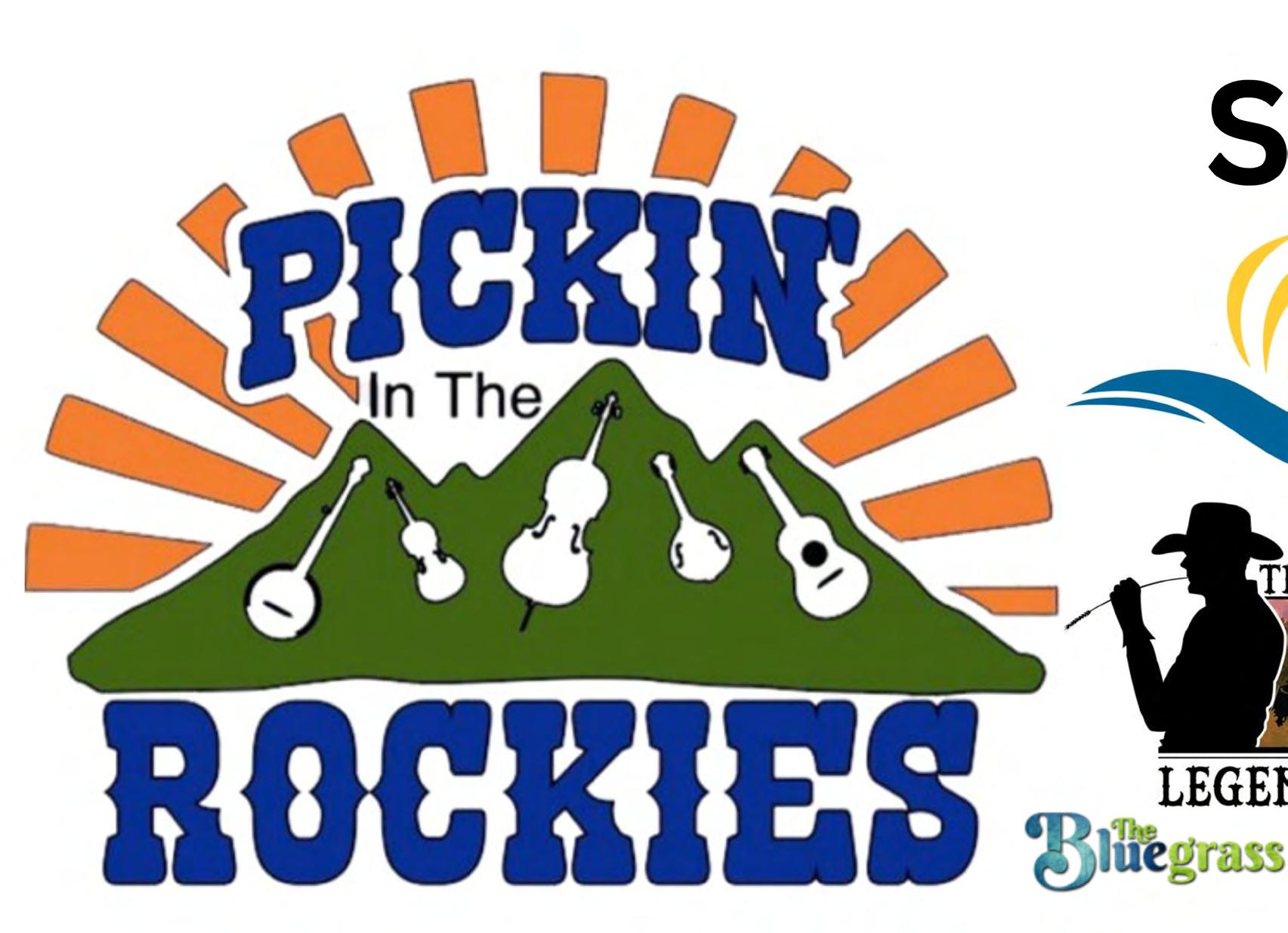
According to Garret Dupper, there’s real value in bringing southern bluegrass to the rugged peaks and valleys of his state of Colorado. While a thriving folk music scene exists across the state, Dupper threw his hat into the ring and produced a new event that showcases the music he loves. The inaugural year of Pickin’ in the Rockies is coming to Loma, Colorado – located near Grand Junction in the western Rockies – on May 26, 2024.
“We are bringing bands out west that are rooted in the heart of bluegrass music,” Dupper said. The Main Stage lineup currently includes artists such as Caroline Owens, Carson Peters & Iron Mountain, Williamson Branch, and
more. Additional well-known headliners will potentially be added closer to the event. The fest will also include local and regional performers such as Keaton Brown and Peggy Malone.
Dupper said the goal is to satisfy local music interests while having notable acts to draw tourists to the region.
“We’re combining the locals with the tourists and making them one,” he summarized.
A big feature of Pickin’ in the Rockies will be the workshops offered. One workshop topic – family dynamics in the music business – is particularly suited to Williamson Branch, who will participate
30

in that event. Family bands have always been a big part of old time, bluegrass and gospel; exploring that relationship between family and the performing arts adds additional depth and context to what the performers present while onstage.
“Workshops will be on the history of bluegrass, and there will be a workshop on the family dynamics of bluegrass and how that brings people together,” Dupper explained.
Part of the event’s goal is to support a new organization associated with Pickin’ in the Rockies.
“It is a non-profit,” Dupper said. “I
founded it and put together the board.”
He decided to do the hard work of putting together a new festival from scratch because his heart lies in both the music and the community. He believes in the role of bluegrass festivals.
“For me, it’s kind of always been something the whole family can enjoy,” he said. “It brings people together in a community sense.”
One aspect of the bluegrass circle that Dupper said stands out to him is that performers are often on a personal level with fans.
“Everybody’s always traveling to see the
31

groups because they became such good friends with them,” he explained, adding that he’s dealt with “country crossover” acts before and found that their demands were greater and their “demeanor onstage is so different.” He described bluegrass performers as being more laid-back and of-the-people.
Dupper said a lot is going on in the area in the days surrounding the festival, which will be held on Loma’s Absolute Prestige Ranch. Traveling to Colorado for Pickin’ in the Rockies will allow visitors to take in other fun events.
“The area is very unique… there’s hiking, mountain biking…several big events that same weekend, like a rodeo and a baseball game,” Dupper said.
Pickin’ in the Rockies will also have craft and food vendors on the festival grounds, including “vendors coming from all across Colorado” that will dish out a variety of delish options, including things such as “BBQ, churros, and funnel-cake sundaes.”
Tickets for Pickin’ in the Rockies are now on sale. For more information, visit Pickinintherockies.com.




32


33
Bella White
by Kara Martinez Bachman

34
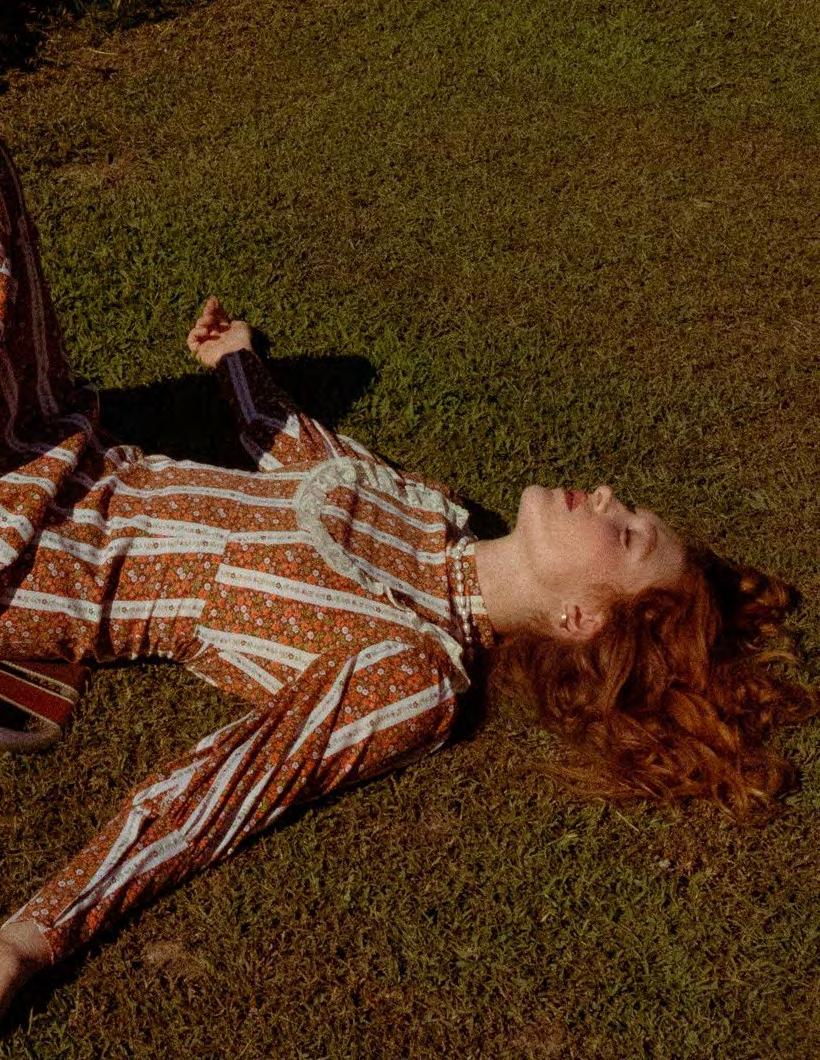
35

Up-and-coming singer and multi-instrumentalist Bella White is said to have brought “old soul” insight and “intense self-awareness” to her debut album, Just Like Leaving. Her sophomore release dropping this month – the bluegrass-steeped Among Other Things – promises yet another evolution of this young artist.
“Among Other Things is a record that I’m very proud of,” White said. “I didn’t write all the songs in the same chapter of my life. It spans over the course of a couple years of writing, and I think that’s partly what bridges the gap from my last record lyrically.”
This performer from Calgary, Canada, said she experienced what many other artists have reported, that she was “inspired by spending a lot of time alone during the pandemic and inspired by watching the world around me and looking at the world within me.”
“I think that listeners have really liked it, and I think it’s exciting to evolve musically,” she explained. “I am very grateful that people were wanting to evolve with me.”
White – now in her early 20s – has been writing music for many years. When she talks about that creative process that drives her work, it sounds almost therapeutic.
“I think that because I was so young when I started writing, I didn’t really think of it as a craft as much as a way to process my feelings,” she said. “I still definitely use it as an outlet for processing, but I think now, I’ve also started exploring the depth of a single song and how I can write in ways that cover more ground and broaden the subject matter I’m writing about.”
White said anyone who wants to hear the new music live might want to catch a show this spring. She’ll be doing a few opening sets for Ashley McBryde and “playing a few headline shows as well.”
In reminiscing about what drew her to bluegrass, she cites what most folk performers mention – early childhood exposure to the music at home.
“I truly grew up on bluegrass and classic country due to my parents’ musical taste,” White said. “A huge part of what draws me to it is the comfort that I find in listening because of that.” Her father was a bluegrass musician who hailed from Virginia. The roots of her connection to the music run fairly deep for a young Canadian gal.
“I also love how ‘straight up’ it is,” she added, describing the genuine, unassuming honesty of bluegrass that attracts so many. “The lyrics are very clear in what they are trying to communicate, which is often a lot of yearning and longing.”
36


37

38
Larry Efaw
by : Susan Marquez

At age ten, Larry Efaw first got on stage with a bluegrass band in his home state of Ohio. When he was seven, he started playing the mandolin and grew up watching his dad’s band, Ed Efaw and the Bluegrass Mountaineers. “He put me on stage with the band when I was ten years old, but I stood in the background and picked a little when I knew something. Every now and then, he’d bring me up to the mic for a solo, but I returned to the back as soon as I could.”
Larry got the hang of it, and he’s made a lifelong career of playing and promoting bluegrass music. While he had opportunities to join national bluegrass bands through the years, he remained loyal to his father. Even so, Larry’s musical career has afforded him the pleasure of playing with many bluegrass greats, including Dr. Ralph Stanley, Jim and Jesse, Doyle Lawson, Bill Monroe, Del McCoury, and Rhonda Vincent. “I was fortunate to have played with the first generation of bluegrass artists, and I learned something from all of them. They were all so nice to me.”
Because of the support, he got growing up, Larry has always made a point of encouraging young people. “If I see young folks jamming at a festival, I stop and join in with them. I learned from other people helping me on my way up, so I try to do the same.”
Ed Efaw started the band in 1962. “Dad knew three chords on the mandolin,” recalls Larry. “When I told him that’s what I wanted to play, he brought a mandolin home and laid it on my bed. He told me not to touch that mandolin. Well, that’s like giving a kid candy and telling him not to eat it. I taught myself to play.”
Sometimes, being in the right place at the right time can change your trajectory. It happened to Larry when he was playing a show in 1987. “We opened for Ralph Stanley. His lead singer didn’t show up, and he asked me to join him on stage. I ended up doing two shows with him. Then he asked me if I’d put on a show.”
Larry told Ralph he knew nothing about putting on a show, but Ralph wouldn’t take no for an answer. “I started calling around and talked with a lady who worked at the O.J. Work Auditorium in Wadsworth, Ohio. She was really nice, and she told me they had held a few shows there, but they didn’t have good attendance. That scared me even more.” The auditorium rented for $25 an hour. They booked the show in March 1987. Jim McReynolds said he’d like to come, and between Bill Monroe, McReynolds, and Larry’s band, they sold out the 1200-seat venue. “It was standing room only, and we had to have local police help escort people out. “Ralph called me and said, ‘You drew a pretty good crowd, didn’t you?’”
39
Ralph told Larry to plan another show in April, but Larry wasn’t so sure about it. They had the show, and the Lewis Family played, then they did a show with Charley Waller and the Country Gentlemen, and they brought in Doyle Lawson. “Pretty soon, we started having the Ralph Stanley birthday celebration there every year. One year, I called Jimmy Martin to come play, but he said he takes off in the winter to hunt. I don’t know how, but I convinced him to come play anyway.”
Larry got so good at running shows that he was asked to run the Coonhunters Club Festival in Greenwich, Ohio. “I ran that festival for a long, long time.” Over the years, Larry and his wife, Lisa, have worked to promote shows and festivals, including the Maumee Bay Bluegrass Festival, Lake Wapusun, Play Pen Park, Clay’s Park, Paradise Lakes Park, and shows in Springfield High School’s George E. Tombaugh Auditorium.
Now Larry and Lisa plan bluegrass cruises. “We’ll be taking our eleventh cruise at the end of October,” says Larry. “It should be the thirteenth, but Covid knocked us out for a couple of years. We were the first to do a cruise after the pandemic.”

40
The cruise idea started at a show when Lisa was talking backstage to Ralph Stanley’s wife, Jimmi. Both wives said they’d always wanted to cruise to Hawaii, but Ralph had no desire to go because he had seen enough water in the service. “Jimmi told Lisa to book it, and she’d get Ralph to go.” As fate would have it, Ralph got sick and couldn’t go on the cruise, but Larry says the performers sang some of Ralph’s songs each evening as a tribute to him.
Larry and Lisa have cruise planning down to a science. “Lisa has a travel agency, so she books all the passengers and works to get them the best cabins,” says Larry. “I book the talent. We never do shows when at port because we want folks to enjoy their time off the boat, but when we are at sea, we have an early dinner, then about three hours of music every night.”
This year’s Bluegrass Cruise to the Caribbean will depart from Port Canaveral in Orlando, Florida and set sail to the Bahamas, stopping at Half Moon Bay, Grand Turk, and Amber Cove. Performers on the cruise will be Larry Efaw and the Bluegrass Mountaineers, Ralph Stanley II and the Clinch Mountain Boys, The Baker Family,

41

“It’s fun to see people who come back year after year for the cruise,” says Larry. “But it’s just as much fun being with first-time cruisers. A lot of them were like me – I was scared to death the first time I got on a cruise ship. But now I love it!”
42
Edgar Loudermilk Band, Corey Zink, and Deeper Shade of Blue.

43

A Q&A with BirdFest Festival Director, Barrett Smith: Inside the 2024 Bluegrass Festival
As the strings of banjos set the backdrop for an unforgettable event located amongst the parade grounds of the Wildlife Education Center in Pinewood, South Carolina, the bluegrass community eagerly anticipates the celebrated BirdFest Music Festival. This year marks its 20th anniversary, promising to be a harmonious blend of old traditions and exciting new offerings. With tickets flying faster than the South Carolina swallows, we sat down with festival director Barrett Smith (of the Steep Canyon Rangers) to pluck out details of the upcoming festivity at the South Carolina Waterfowl Association Wildlife Education Center.
BirdFest 2024: A Symphony of Strings and Storytelling
Q: Tell us about this year’s 20th BirdFest Music Festival and why people should attend?
Barrett Smith (BS): BirdFest has always been more than just a festival; it’s a community coming together to celebrate the quintessence of bluegrass music. This year, being our 20th, we’re pulling out all the stops. From the legendary Steep Canyon Rangers to the vibrant Chatham County Line, the lineup is electrified with talent. Attendees will not only experience the soulful sounds of bluegrass but also the natural beauty of the Wildlife Education Center. It’s a family-friendly event where folks of all ages can enjoy music, nature, and each other’s company.
Q: How do you pick the bands and structure the lineup?
BS: Our goal is always to create a dynamic mix that honors bluegrass roots while also showcasing the genre’s evolving landscape. We look at a variety of factors: musicality, energy, audience appeal, and the artists’ engagement with the bluegrass tradition. The lineup is structured to take you on a journey, with each band’s set building on the last, culminating in these almost magical headlining performances under the stars.
Q: How did the festival start 20 years ago?
BS: BirdFest began on a quail plantation farm, and they had this grand old mare mule named “Bird.” She stuck her head out of her barn and always greeted us. She had a quiet disposition and I like to think she really enjoyed the music. We didn’t have a stage back then, but played on an old hay wagon and just sort of made it up as we went along. It was just our friends playing and jammin’ along. We are keeping that vibe, even though Bird is long-gone, and we’ve moved to the Wildlife Education Center.
The Sweet Sounds of Success
As our conversation winds down, the anticipation for BirdFest 2024 crescendos. Beyond the promise of exceptional bluegrass performance, a sense of community and shared joy resonates.
Key Takeaways for Festival goers:
• Dates: May 3-4, BirdFest 2024 promises to be an unforgettable showcase of bluegrass brilliance.
• Tickets: Available now! Secure VIP passes, Weekend Passes along with RV spots, tent camping and tailgate tent spot at BirdFestMusic.com.
• Lineup: Featuring big names like Steep Canyon Rangers, Chatham County Line, Jon Stickley Trio, Big Daddy Bluegrass Trio, among others.
• Experience: A family-friendly, all-ages event intertwining music, education, and the great outdoors. Free activities for the littles such as face painting, rock wall climbing, zip line and much more. Remember, bluegrass isn’t just music; it’s a story we all write together, one song at a time.
44

45


46

Bon App-alachia: French food & wine find home in WV
by Candace Nelson
White linens drape the tables, and champagne-filled flutes line the bar. Soft classical music plays in the background. The featured menu item of the day is escargot - cocoa and chamomile cure, plum compote, chamomile sauternes jelly and toasted brioche.
But this isn’t Paris. Or Marseille. Or Nice.
It is The French Goat in Lewisburg, West Virginia.
This small, French-style bistro is located in a historic mountain town of about 4,000 people and serves a menu of classic French dishes - that originated some 4,000 miles across the Atlantic - with a twist.
“I love classic dishes and flavor combinations, and I try to pay homage to the classics by recreating them with available local ingredients and my own spin,” said Hannah Reid, chef at The French Goat.
“Trying to keep in mind that simple food is often my favorite, I seek to balance being true to the ingredients and concepts while still having a bit of fun.”
Take, for example, the restaurant’s Crisp Duck Confit, accompanied by barbecue sea island red peas, cauliflower whipped potatoes, charbroiled carrots, and winter cress in warm maple-bourbon vinaigrette.
“We feel that Duck Confit is one of the classic French dishes that should be on a bistro menu, and this recipe is a classic confit preparation of the duck and a playful and tasty use of vegetables for the accompaniments,” she said.
Other classic dishes include Foie Gras Torchon with onion marmalade, cornichon, toasted brioche and sauternes gelee; Croque Madame with griddled farmhouse bread, country ham, gruyere cheese, mornay sauce, fresh hen egg and frites; and Tuna Nicoise with seared ahi tuna, haricot verts, hard egg, fingerling potatoes, olives, baby greens and balsamic vinaigrette.
Delectable desserts include the chef’s daily creme brulee, chocolate mousse with whipped cream, and an apple and almond cake with butterscotch sauce, calvados, and whipped creme fraiche.
“Whenever I get a chance to travel, I try cuisines, restaurants, and ingredients that are new to me, and I get an urge to replicate some of these things in my kitchen,” Reid said.
47

“It’s not that I copy exact dishes, but I get excited to try and recreate some of the flavor combinations and techniques that really stand out to me. I want to reproduce for our diners the same sense of euphoria that I experience when I have a truly memorable meal.”
At a young age, Reid enjoyed her first life-changing bites that would ultimately feed her life’s passion.
“I was a dishwasher at a French bistro when I was a teenager, and the chefs were always feeding me ‘exotic’ dishes and ingredients that I assumed I wouldn’t like,” Reid, who grew up in the foothills of the Appalachian Mountains in Albemarle County, said.

“However, I did not want to be rude and turn down food, and I realized that I loved everything I tried. Between this epiphany and a newfound love of the frenetic atmosphere of the kitchen, I was hooked!”
After years of ascending the ranks across kitchens in Appalachia, Reid began leading the culinary team at The French Goat fairly in recent years - though the restaurant itself has been open for nearly a decade.
48

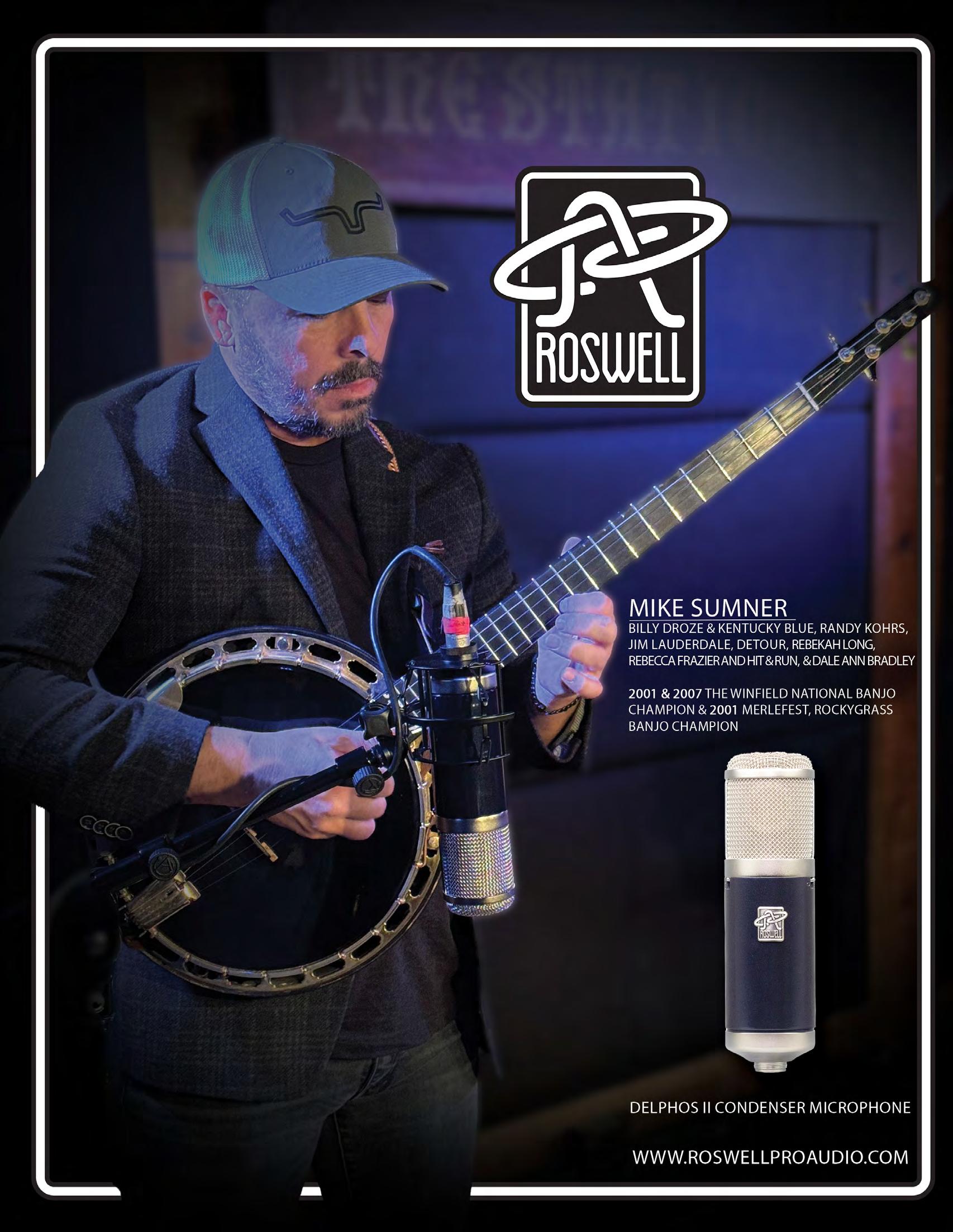
49

In 2015, The French Goat proprietors Debbie Porter and Arthur Forgette pursued their lifelong passion for French food and wine. They realized their dream of opening a restaurant after leaving the hustle and bustle of Washington, D.C., in favor of returning to family roots in the rolling hills of West Virginia.
“Arthur and Debbie combine his vast knowledge and 30 years of experience in the hospitality industry with Debbie’s New York marketing and sales background to open The French Goat,” according to the restaurant’s website.
Today, Porter and Forgette’s vision pairs perfectly with Reid’s culinary execution - like Bordeaux and Camembert. Chablis and oysters. Sauvignon Blanc and chevre.
“An excellent mentor and teacher, Chef Hannah Reid sets the tone for excellence and consistency within her team. She brings a wealth of culinary knowledge and experience to The French Goat, and her creativity and talent have positively impacted the culinary team,” according to the website.
It is a match made in almost heaven. Or France.
The French Goat is at 290 Lafayette Street, Lewisburg, West Virginia, 24901. The restaurant is open for dinner Wednesday through Sunday from 5 p.m. to 9 p.m. It is open for brunch on Sundays from 11 a.m. to 2 p.m. The phone number is 304-6471052. For more information, visit https://www.thefrenchgoat.com

50


FAN PHOTOS


51





52



53

54










































































































